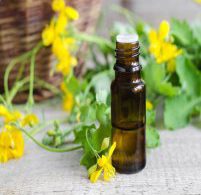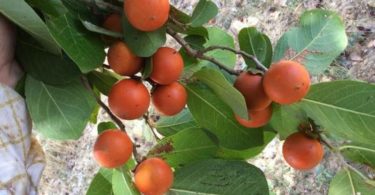Tincture of the root
Triturations of the aikaloid have been used
Sanguinaria is a comparatively recent addition to the materia medica but has established itself as a valuable remedy more especially in acute and sub acute disorder . it contains small
Quantities of alkaloids , chemically allied to those of opium , which paralyse sensory nerve
Ends locally , make the heart beat more slow and tend to excite the central nerves system . sanguinaria , for instance , can cause tetanus and mental excitement , and violent peristalsis .
It also increase the secretion of saliva . traces of these actions are found in the proving where the whole complex becomes reasonably clear and precise enough to prescribe on . in its alkaloidal principals (which are by no means the only source of the drug symptomatology )
Sanguinaria also resembles chelidonium and in homoeopathic practice we find a good many reasons for associating the drugs together in the mind . Sanguinaria was used as a domestic remedies long before it was proved , mainly for “colds” . It will be seen that the tests on the healthy give plenty of warrant for the use of the drug in some catarrhal affections of the nose and bro nchi and deeper diseases of the lungs . Sanguinaria is not a remedy of very long lasting power , and consequently it is more often prescribed upon local symptoms than upon general constitutional ones . with drugs this class mental and temperamental symptoms are relatively of less importance than with the profound and searching remedies of our material medica. Nevertheless Sanguinaria shows a not worthy mental peculiarity in its pathogenesis that man prove a valuable guide . this is a hopeful disposition , an expectation to recover on the part of the patient , which is sometimes marked in quite grave cases . it recalls indeed the the famous hopefulness of the phthisical , for it has no relation to the seriousness one of the most valuable remedies in the acute stages of pulmonary tuberculosis on other grounds and the presence of the mental symptom is a strong additional indication for it is however true that this classical symptom is much less frequently observed now than seen to have been the case in earlier years , probably because there is so much popular knowledge and half knowledge disseminated to day about tuberculosis , that it is rare to meet a case where the mental symptoms are not influenced there by . Sanguinaria is often indicated in the absence of this mental symptoms but its presence is a note worthy suggestion for the use of it . the respiratory organs are much influenced by Sanguinaria .The nasal mucous membrane is inflamed with a rather scanty discharge , which is usually acrid and causes very marked burning sensation .Burning of the nose and pharynx , burning of the tongue which is often red and not coated , these symptoms are often marked enough to recall arsenicum. If the discharge is free it is generally watery , which suggests that there is little or no leucocytosis and often the nasal condition that need sanguinaria are chronic with thicken9ng of the mucus membrane , and enlargement of the turbinates . nasal polypus has been often treated with it locally and constitutionally . it certainly is suited to some of the chronic catarrhs which
Precede polypus formation . te sense of smell is lost or perverted and there may be a great sensitiveness to the scents of flowers . hay fever is a condition which often benefits from sanguinaria , especially when there is great nasal obstruction and burning sensation but relatively little discharge . asthma may need it when there are nasal symptoms , and with this is and hay fever there is generally definite disturbances in the gastric or hepatic reasons also before this dug is well indicated . descending the respiratory tract there is found a dry burning condition of the throat , a spasmodic laryngeal , cough , which often causes omitting (as if droscera)
,and this is specially indicating of the remedy when it is worse at night and accompanied by diarrhea . woophing cough occasionally does well on it and for post influenza cough in from epidemics it is nearly specific since the sanguinaria cough can be fairly described as dry , exhausting , spasmodic and distressing , getting worse towards night and on lying down and on exposure to cold air , it will be readily seen that the drug has claims to consideration in this most intractable condition . burning , indeed is almost as much a future of , sanguinaria as of sulphur or arsenicum . whenever there is sensory disturbance in a patient likely to need the drug burning will be prominent in the description symptom . it may be complained of any where , eyes , ears palms and soles , chest and . abdomen .Burning between the breasts has been used as a special indication for the use of Sanguinaria in pulmonary tuberculosis , but beyond this uncommon symptom the drug complex is frequently recalled by the acute stages and especially the early stages of phthisis . the charectersti cough has been already described . it is irritative distressing and rather in effective , worse at night and the sputum is seldom excessive but may be offensive and blood stained . stitches of pain may be pain may be complained of cheeks are congested and classical localized hectic flush is often seen . or there may be a wide spread rather dusky patch recalling those of opium to which sanguinaria is botanically allied . but except for the cheeks the face is generally pale . hope fulness of disposition has been previously commented on asa possible addition to the picture sweating is not as a rule very marked . the cases of tuberculosis which do well on sanguinaria are nearly always early onces . Here compete with sulphur and phosphorous It is not nearly as profound in its action as these remedies . but for that reason it is often preferable to test the powers of reaction in tuberculosis with it , for it is well known that sulphur or phosphorus incautiously used may caused dangers aggravations of tubercular nung affections . there is also a well known smoildering type of phthisis , almost incurable ( though the patient live for years ) , and subject to exacerbations and times of improvement Sanguinaria is most helpful during the acute stages of this type of disease , and though it will not cure it those much to prolong life and make it more endurable . in such cases the deeper acting remedies are often dangerous and careful discrimination both of drugs and of potencies is called for . early cases whom sanguinaria suits generally do well on sanatorium t reatment . damp weather distresses them but the air is often liked though the change from warm to cold air may start the cough they do not as a rule take kindly to the heavy feeding of sanatoria , which is , how ever , not nearly so much insisted on as formerly .as will be seen presently , gastric and abdominal symptoms . are note worthy in the pathogenesis of . Sanguinaria beside acute and sub acute tuberculosis , sangeuinaria has a value in some cases of pneumonia . Like chillidodnium it affects the right side most . the characteristic , cough of t his remedy is frequently met with in pneumonia and the burning sensation may give an additional hint . the symptoms Empty erructations after coughing “ , is said to the a key note if it should occur . the “ right sidedness” of . sanguinaria should be remembered in tuberculousis also .
The alimentary canal in its upper part is considerably affected by this drug The main symptoms are gastric and hepatic , and with them is generally associated a head ache of a kind to the presently described . the chief local symptoms of dyspepsia are vomiting , acrid and burning eructation burning pain in the hypogastrium the tongue is seldom heavily coated , it may be red and generally burns as does also the phaynx . nausea , is not much relieved by vomiting , the vomit is sour bitter and acrid and frequently contains much bile . the catarrh extends to the duodenum and the secretion of bile appears to be increased . at the beginning of a dyspeptic attack such as suggests Sanguinaria , most of the bile is vomited , but later it seems to follow the normal course and produces a profuse bilious diarrhea . the lower bowel is little affected directly by the drug attacks of this kind are often brought on by indiscretions in diet , they suggest an irritated rather than an inflamed gastro duodinall mucus membrane and a considerable disturbance in the hepatic functions . the body attempts to get rid of material that seems useless or harmful to it , and the vomiting and diarrhea ensue . frequently at some stage in the attack there is shrinking empty abdominal sensation that is not hunger . Indeed there is often aversion from sight or smell of food as with colchicum , but the patient may easily take to alcoholic stimulants to , combat the ‘sinking ‘ , and sanguinaria as a real place in the treatment of dyspepsia of drinkers . during the gastric attack comes nearly always the head ache attack and head ache are frequently periodic , as often as every week even .In women the menstrual period is apt to be associated with a severe sick head ache . homoeopathist naturally look at symptom complexes as entities whose detail are inter dependent , not arbitrary , and the gastric and hepatic and head symptoms of Sanguinaria are to the considered in relations to the respiratory effects of the ug already mentioned . whenever there is faulty metabolism and periodical accumulation of waste products and violent attempts at elimination ( and in some such a we have to read the sanguinaria picture in its gastric aspect ) othr mucus surfaces are apt to the irritated and any infection of than to become chronic . Similarly toxins of respiratory diseases may react on metabolism . the dyspepsia of early phthisis , is notorious and indication for Sanguinaria in that disease can be looked for in the abdominal as well as in the chest symptomatology
The pain in the head usually precedes the gastric symptoms . it begins in the morning and goes on day . movement aggravate as much as when brynonia is to be thought of , and strong , sensory stimuli area hardly endured . sensitiveness of the skin is marked . above the right eye is a very characteristic spot of maximum intensity , and the pain often begins in the occiput and comes over the head to settle there . sleep relieves the patient . further these cases of faulty elimination almost invariably disply pain symptom affecting nerves muscles and joints with Sanguinaria , the joints escape as a rule but pains of a neuralgic charaeter , severe and tearing , frequently met with , also pain and stiffness and hampered movement of groups of muscles , especially about the neck and sshoulders . stiff neck , pain in the deltoid reason ( right sided probably ) , inability to use the arm freely , pains extending up into the head , all these symptoms are to be noted in those who need Sanguinaria . the pain are severe aggravated by movement and at night the last two symptoms help to distinguish Sanguinaria fro ferrum for these complaints .
It will be seen that the range of action of the drug is considerable and its intensity also but as already been said , it has not a long lasting effect or one of a profound and searching quality . in the earliest stages of similar , complaints it is curative , in later stages its palliative action may be invaluable when more deeply acting remedies might be dangerous . I t has been praised in all potencies , and like most of the drugs of shallower action even high potencies can be repeated with benefit with out very prolonged intervals between the doses . but her , as always , the wise prescriber follows the rule of taking any improvement in the patients condition as an indication in the mind with Chelidonium and Opium , but it seems to antidote the later .





